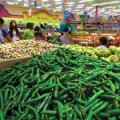The contemporary focus on fresh ingredients pales when compared with the Chinese custom of purchasing live fish for immediate consumption. Silicon Valley has a large number of Cantonese and Hong Kong restaurants where fish can be selected and presented tableside within minutes of ordering. Preparations are simple and delicate, bringing forward the taste of the fish itself.
But in these restaurants, the dishes are never on the menu and can present a challenge for diners without familiarity with the practice of ordering this simple and delicate dish.
Fresh fish is sold by weight. When ordering, start by clearly stating “fresh fish,” which begins the negotiation. The size, weight in pounds, is the first item discussed. For a small group, a fish in the 1.5-to-2-pound size will be an ideal addition to a meal. Weights below 1.5 pounds are more difficult to cook and should be avoided. After determining the size, ask which fish types are available.
In this area, the most common smaller fish is black cod. Specialty fish are the Australian coral trout and rockfish, a large, red fish that sleeps on its side. Prices can be high. Last week, prices for cod ranged between $12 and $28 per pound. One restaurant posted the price of the prestigious Australian reef trout at $57 per pound.
Although other preparations may be available, the standard steamed option is best. In this style, the fish is steamed whole with scallions, ginger and a light soy sauce. The combination amplifies and complements the taste of the fish with just the lightest of salty, neutral broth. Fish can also be ordered “two ways,” where the meat is served alongside a simple soup made from the bones and head. This option may not be available for smaller fish.
Fish will always be brought to the table with the head attached and the bone in. Correctly cooked fish can easily be pulled from the bone. If it flakes too easily, it is overcooked, and undercooked if it clings. The waitstaff may offer to use the two spoons provided to separate the meat from the bones by carefully grasping and pulling the meat, then flipping over the fish and repeating. The head should not be eaten, although the minuscule fish cheeks are considered a delicacy.
Clams, crabs, spot prawns and lobster may also be available. More complicated to order, these are available in a variety of preparations, but ordering is the same. Discuss first the weight and price, then ask about available preparations.
Mayflower Seafood Restaurant on Barber Lane in Milpitas is the southern branch of the Mayflower restaurants in San Francisco and Union City. Barber Lane holds two Asian-focused malls. Mayflower is more accessible for the new fresh-fish eater with English-language postings by the tanks listing the kinds of fish available and price per pound.
Prices can be high. Black cod was $28 per pound in a recent visit, and a single-pound fish made for a very light meal. The preparation was unusually succulent, with the ginger, soy and scallions mixing melodiously, creating a light broth that invited dipping and swirling. The fish, while it couldn’t have been fresher, had some exceptional bites, but sections along the back were tougher and had a fishier taste.
Fu Lam Mum, on Castro Street in Mountain View, had no menu items or prices listed, but the tanks were crystal clean, and the fish quite fresh. The fish were lively and active, with the cod hovering together staring at the diners.
On a recent visit, the cod was on special, with a sandwich board out front listing a price of $15 per pound. The sauce didn’t have the same brilliant combination of Mayflower’s, but the fish itself tasted clean and bright. Fu Lam Mum is open and lively until midnight every night, and has a special late night dim sum menu, too.

 Murder Mystery Dinners at Bella Mia
Murder Mystery Dinners at Bella Mia  Livefeed: Lucky 13
Livefeed: Lucky 13 


